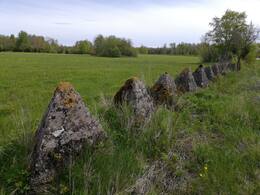Kaimri gynybos linijos pabaiga
1941 m. rugsėjo 16 d., dėl sėkmingo vokiečių kariuomenės puolimo Muhu ir Saremos regione, buvo pradėtas darbas ties gynybos linija tarp Lõpe, Teesü ir Kaimri kaimų.
1941 m. rugsėjo 16 d., vokiečių pajėgoms sėkmingai įsiveržus į Muhu ir Saremos salas, sovietų pajėgos pradėjo statyti Lõpe-Teesu-Kaimri gynybos liniją.
Tai buvo trečioji tokia linija, kuri buvo nutiesta sąsmaukoje, o vietos gyventojai buvo įdarbinti padėti ją statyti. Priešais jį buvo nutiesta betoninių užtvarų prieštankinė linija su papildomomis vielinėmis kliūtimis.
1941 m. rugsėjo 30 d. Raudonoji armija pasitraukė už linijos. Po dviejų dienų mūšio vokiečiai pralaužė savo gynybą, o spalio 5 d. pasidavė tai, kas liko iš Raudonosios armijos pusiasalyje.
1944 m. spalio 21 d. vokiečių kariuomenė Sõrve atsiliko nuo linijos, kaip ir prieš trejus metus sovietai. Jie taip pat panaudojo 1941 m. pastatytą prieštankinę liniją, prie kurios pridėjo papildomų laidų kliūčių ir pastatė sausumos minų. Jie pavadino jį Leo-Riegel, reiškiančiu Lõo skersinį. Po visą mėnesį trukusios aklavietės Raudonajai armijai 1944 m. lapkričio 18 d. pagaliau pavyko užvaldyti vokiečius ir pralaužti jų linijas. Kovoje su dviem vokiečių pulkų grupėmis sovietų pajėgos buvo sukaupusios 970 haubicų ir minosvaidžių, 150 tankų ir savaeigės artilerijos bei 45 000 karių. Mūšiai pusiasalyje tęsėsi iki 1944 m. lapkričio 24 d., kai vokiečių kariuomenė evakavosi į Kuršą.
Susijusios vietos
Lepės-Kaimri prieštankinė linija
On 16 September 1941, Soviet forces launched the construction of the Lõpe-Kaimri antitank line to halt the German advance. It runs from west to east in the southern part of the isthmus of Sõrve Peninsula, which is just 3.2 km wide at this point. Comprising two rows of concrete pyramids stretching 900 metres from Lõu Bay to the village of Teesu, the antitank line is in good condition. It is made up of two rows of pyramids standing 0.8 metres high and spaced one metre apart. Parts of the fairly well preserved antitank line have gaps in them, indicating points at which the enemy broke through. The site is easily accessible and can be clearly seen from the road running down the western side of the isthmus. The line is the site of a monument unveiled in 1969, depicting a tall concrete pyramid, which reads: “Lõpe-Kaimri antitank line, built in 1941”.





